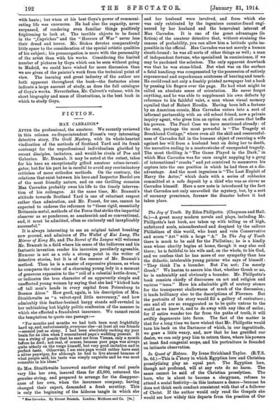GOYA.*
UNTIL the production of the present volume there had not been a full Life of Goya in English. Mr. Stokes, in supplying the deficiency, has spared no pains in collecting all the information available, and where there was none to collect, as in the case of the early years of the painter, he makes up for the lack of material by speculation. When all has been said, we are doubtful whether it was worth while to write the Life of Goya so fully, for although turbulent and passed in stormy times, it was not interesting. It is the artist that arrests us, not the man. In spite of Mr. Stokes's attempt to explain things, Goya remains a veritable and ignoble Vicar of. Bray, who clung to a Court appointment under various. Kings, including the Napoleonic interregnum. Indeed, both from want of patriotism and of moral sense, Goya presents an unattractive figure. His one redeeming quality was his vital energy, which was enormous, and enabled him to pour forth a vast amount of work. Goya possessed the two opposite qualities so often found in great painters—lie had a vivid imagination and a mind overflowing with images of his own creation, and at the same time he could be intensely receptive of the personality of others, and thus was able to produce portraits of the highest order. Like many artists of volcanic nature, his output was very unequal, and he seems to have often worked.
• Francisco Goya. By Hugh Stokes. London Herlert Jenkins. [1.0s, 111, net.]
with haste ; but when at his best Gova's power of communi- cating life was enormous. He had also the capacity, never surpassed, of rendering even familiar things positively frightening to look at. The terrible objects to be found in the ",Caprichos" and the "Horrors of War" never lose their dread and terror. Mr. Stokes devotes comparatively little space to the consideration of the special artistic qualities of his subject; his preoccupation is more with the personality of the artist than with his works. Considering the limited number of pictures by Goya which can be seen without going to Madrid, we could have wished for more discussion than we are given of the painter's work from the technical point of view. The learning and great industry of the author are both apparent throughout the book—the footnotes alone indicate a large amount of study, as does the full catalogue of Goya's works. Nevertheless, Mr. Calvert's volume, with its short biography and mass of illustrations, is the best book in which to study Goya.



























































 Previous page
Previous page